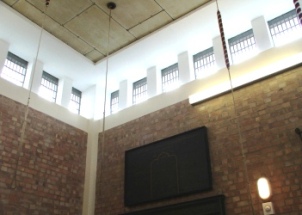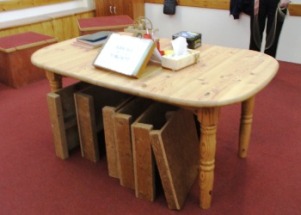


| Dean Addleshaw Tower - the Headquarters of the Guild | |||||||||||||||||||
|
The following history of the Addleshaw Tower has been extracted from the Guild's Centenary Booklet published in 1987. It was written by the now late C. Kenneth Lewis.
At the foot of this report are photographs taken in the Ringing Chamber shortly after refurbishment in 2008 comprising, in the main, the painting the bare concrete sections of the wall and also the acquisition of a new table.
"Towards the end of 1963, it was found that the Cathedral bells were in need of
a complete and thorough overhaul and ringing was suspended. In his Diocesan
Letter of May 1964, the Lord Bishop (the Rt. Rev. Gerald A. Ellison), himself a
ringer, expressed his regret that the Cathedral Church of the Diocese no longer
had a ringing peal. It was not entirely fortuitous that his letter should appear
just prior to the Annual Meeting of the Guild, a fact of which he was most likely fully aware. However, in the event, that matter was brought up at the meeting and the Guild officers were instructed to seek a meeting with the Dean, with a view to encouraging him to launch an appeal for the restoration of the bells and also to guarantee a thousand pounds from the Guild if such an appeal was launched. At the time, the Bell Restoration Fund had about £250 in it and to
guarantee £1000 with a membership of 639, was an act of faith which was later
justified. A meeting was arranged with the Dean, who received the idea with
enthusiasm but, whilst the Dean and Chapter would cordially recommend the
appeal, they could not, in view of their commitment to the general restoration
of the Cathedral, take part in the running of the appeal. They willingly gave
permission for the Guild to run it and the Dean made several useful hints on
procedure which he felt would be helpful. One of these was the preparation on
a branch basis, of potential donors and he asked that he be provided with a copy.
The officers went away to implement the appeal by the preparation of a
brochure and the preparation of the list mentioned above. When the brochure
was almost ready for distribution, containing the appeal for £15,000 and
recommendations from the Lord Bishop and the Lord Lieutenant, Viscount
Leverhulme, a meeting was held with the Dean who, to the officers' consternation, announced that the Dean and Chapter had changed their minds and the
appeal for the bells would be included in the General Appeal for the Cathedral.
By September 1965, the Dean had asked Mr George Pace, Architect to York
Minster, to prepare specifications and, in January 1966, these specifications
were produced and estimates invited. In October 1966, the Architect reported
that estimates had been received for the recasting of the bells and the new bell
frame and also for the electrification of the clock and tolling mechanism, but it
was impossible to obtain a firm estimate for the builder's work. One firm did
submit an approximate estimate.
It had been discovered that one of the beauties of the crossing was the upper
arches and gallery and the architects report said, "This fine conception is of
such architectural importance that, at all costs, it must remain unobscured".
This meant that the bells would have to be installed in the same undesirable
situation as the old peal and the frame would be at a level where it would be a
potential menace from a structural point of view. In view of the structural
objections and immense cost of builder's work, very largely due to the extreme
difficulty of getting access to the central tower over the high roofs of the
transepts, Quire and Nave, the architect suggested that serious consideration
should be given to the building of a specially designed Bell and Clock tower on
the portion of land at the south east corner of the churchyard.
This report was duly conveyed to the officers of the Guild by the Dean, together
with a sketch of a proposed bell tower. At the same time, the Dean emphasised
that it was a question of the money and that the Dean and Chapter must spend
wisely. He said that there was much to be done in the Cathedral and that the
huge cost of the suggested bell tower precluded them from going ahead with
it. The meeting was astounded and proceeded to comment on the findings. It
was pointed out that with modem materials, the cost of the new tower could be
considerably reduced and drew attention to the recent series of suggested
structures presented in the Ringing World. A further point was made, that the
officers did not think it appropriate that the new tower should be a structure
which actually copied the structure of the Cathedral, but should be of the
twentieth century and represent the present day addition to the Cathedral, but
should harmonise with it. The Dean listened very patiently to what, at times, was a rather heated discussion, but in the end he said that he could not commit
the Dean and Chapter to any such scheme. The officers were extremely downcast and were of the opinion that this was the end of the dream of a new peal at
the Cathedral.
Nothing happened for some considerable time but the
Master, Mr John Worth, died early in 1967 and the Dean arranged a very moving
memorial Service in the Cathedral and was, I think, surprised at the great
number of ringers present from all over the Diocese and the Exercise. Some little
time later, the General Secretary, Mr H.O. Baker, received a telephone call
suggesting that he visit the detached towers in Herefordshire and take photographs and details and the Dean would do the same independently. This
exercise was carried out and on 4th July 1968, the Dean and Chapter announced
that they proposed to build a detached tower in the south east comer of the
Cathedral burial ground. The Dean negotiated planning permission with the
City Authorities and, at the same time, arranged the programme of ringing
which would take place when the tower was built and the bells in place.
It must not be assumed that everything was easy; there were elements in the city
who were opposed to the tower and considered it a waste of money.
Some of the local clergy feared that their ringers would be tempted to leave their
parish Church, but the Dean was undaunted and pursued his objective firmly
and refused to be intimidated.
Early in 1969, a public announcement was made of the scheme and attracted
nationwide publicity as the first detached bell tower to be erected since the
fifteenth century. Sadly, shortly afterwards, the General Secretary, who had
put a great deal of thought and work into the project, died, but not before he had
had the honour of handing over to the Dean, under the crossing of the
Cathedral, the Guild's cheque for the thousand pounds promised.
The officers were kept informed of the progress of the work. Outline planning
permission was obtained in March 1971 and work began in February 1973. But
before this, in February 1969, nine of the ten bells were removed from the
Central tower of the Cathedral, over the roof to the bell foundry of John Taylor
and Co., to be recast as a ring of twelve with a flat sixth. Two old bells were left
in the tower. Henry Oldfield's bell of 1606 and William Clibury’s bell of 1626.
It is said that the bell founders removed the Oldfield bell by mistake and had to
take it back.
The foundation stone was laid by the Lord Lieutenant, Viscount Leverhulme,
on Saturday, 16th June, and the Master of the Guild, Mr Basil Jones, read the first
lesson and officers and members of the Guild rang a course of Grandsire Triples
on the Cathedral handbells immediately after the laying of the foundation
stone.
About the middle of 1974, the Guild, with the active cooperation of the Dean,
arranged for a Ringing Course in the Refectory on 11/12th October, with
Frederick Sharpe F.S.A., to give a general lecture to the embryo Cathedral band
and their relatives and friends on 'Bells', followed on the following day, by a
course of a more technical nature aimed at the learners and their teachers. This
was well supported by those concerned and by members of the Chester Branch.
On the Friday evening before the general lecture, as the bells had arrived and
were in the base of the tower, a short service of blessing was held, conducted by
the Dean. In the following days, the bells were hung and a trial run took place
on Wednesday, 23rd October. On Wednesday, 26th February, 1975, a final try
out took place with the bell founders present. On 8th March, the bells were rung
for a wedding for the first time, the bride being a member of the Grosvenor
family.
During all this time, the Dean was in close touch with the Officers and, pending
final arrangement, appointed the Diocesan Secretary, John Ledsham (a ringer),
as Secretary Co-ordinator for the Bell Tower. It was arranged that the Sunday
afternoon ringing should be undertaken by the Branches of the Guild on a rota
system. The Dean was extremely anxious that this ringing should be undertaken by parish ringers throughout the Diocese, as a means of establishing and
maintaining closer links between the Cathedral and parish towers. This ringing
began on April 6th, 1975.
The opening of the new free standing Bell Tower took place on Wednesday, 25th
June 1975, by His Royal Highness, the Duke of Gloucester, who caused a hiatus
in the arrangements by ascending the vertical ladder to the bells to have a look
at the structure and the bells. As part of the ceremony, each bell was rung
separately by a ringer from thirteen towers in the Chester area: Robert Nightingale (Tarvin), David Adams (Handbridge), Trevor Holmes (Hoole), Harry
Furness (Christleton), Phyllis Jeffs (Cathedral), George Weaver (Aldford),
Stephen Langford (Tattenhall), Robin Parry (Waverton), Denis Millward (Buckley), John Tilston (Dodleston), David Andrews (Eccleston) and Christopher
Roberts (Pulford).
At the conclusion of the ceremonies, which included the presentation of the
ringers to the Duke, a peal of Kent Treble Bob Maximus was rung by a representative band: Basil Jones (Master), John G. Hallett (Chester), John W. Griffiths
(Chester), Anthony P. Foster (Wirral), C. Kenneth Lewis (East), Geoffrey C.
Sparling (Wirral), Michael Thomson (Mid Cheshire), Roland W. Morant (Crewe),
Alexander J. Martin (Secretary), Frank R. Morton (Crewe), Alan F. Scholfield
(Report Secretary) and Denis Mottershead (East). The composition was by
former Master, John Worth, conducted by the Master, B. Jones.
In March 1977, the Dean and Chapter made appointments as Ringing Master -
Mr D.J. Adams and as Tower Keeper - Mr C. Roberts. These appointments made
the post of Cathedral Tower Secretary obsolete and Major Ledsham retired. The
Guild, on its side, made the Cathedral Ringing Master an ex-officio member of
the Guild Committee.
The Dean and Chapter, from the very beginning, made it quite clear that the
Tower was to be considered the Headquarters of the Guild and that all members
would be welcome to ring there. It should be mentioned that the ground floor,
with its kitchen equipment, was provided at the expense of the Branches under
guidance of a Ladies Committee chaired by Miss Wendy Jones.
The Guild may consider itself fortunate in having such a Headquarters, with a
modern peal of twelve bells available."
|
| REFURBISHMENT OF THE RINGING CHAMBER 2008



Painted area at seat level
| Painted area at window level
| The new table
| | |||||